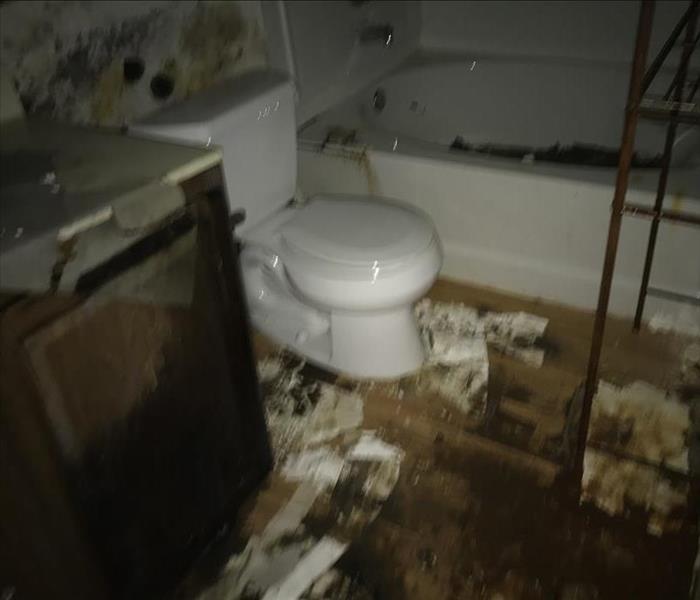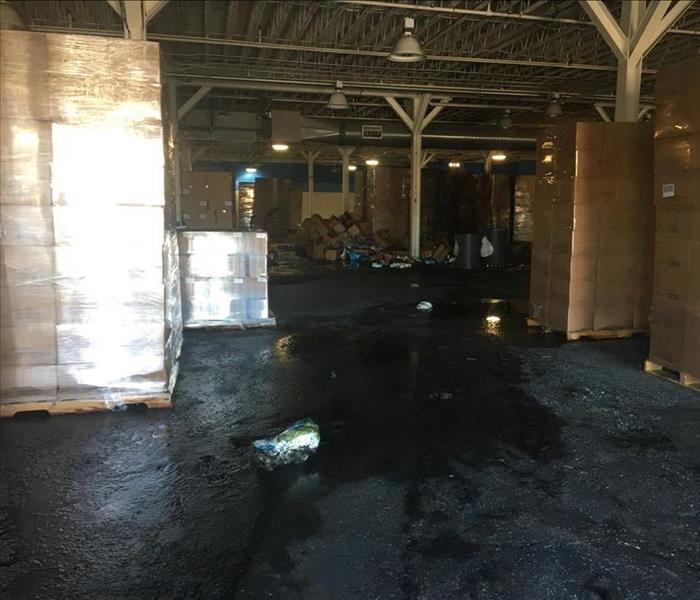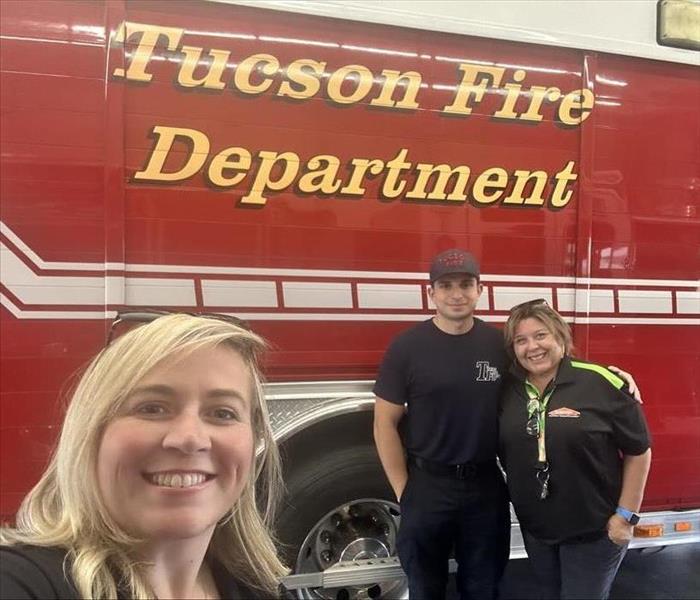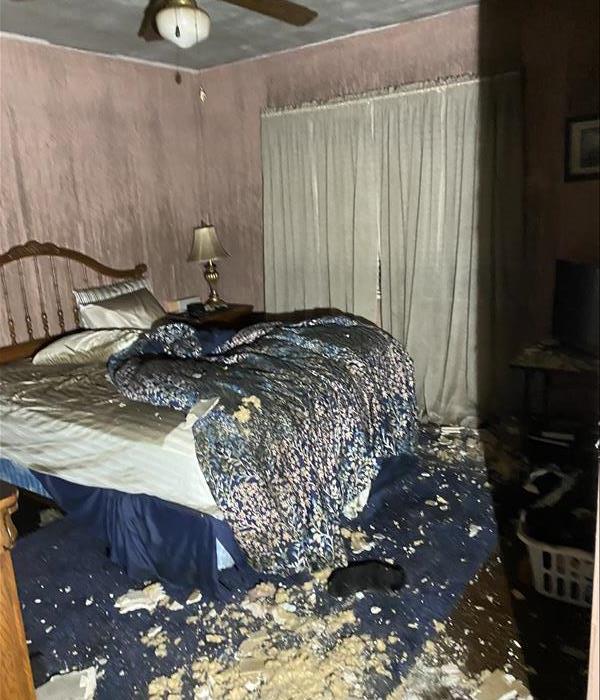Recent Fire Damage Posts
The Step-by-Step Process of Fire Damage Cleanup: Expert Insights from SERVPRO®
12/18/2024 (Permalink)
 wW’ll break down the fire damage cleanup process, step by step, using expert insights from SERVPRO®.
wW’ll break down the fire damage cleanup process, step by step, using expert insights from SERVPRO®.
When a fire occurs, the immediate danger might end once the flames are extinguished, but the restoration process is just beginning. Fire damage cleanup requires specialized knowledge and expertise to ensure that your property is restored efficiently and safely. With fire damage affecting everything from the structure of a building to personal belongings, it’s essential to follow a thorough, step-by-step process to ensure nothing is missed.
According to the National Fire Protection Association (NFPA), there were 356,500 home structure fires in 2020, leading to $7.3 billion in direct property damage. This highlights the importance of acting quickly and correctly when it comes to fire damage restoration. In this blog, we’ll break down the fire damage cleanup process, step by step, using expert insights from SERVPRO®.
Step 1: Emergency Contact and Assessment
The first step in the fire damage cleanup process is to contact a professional restoration company like SERVPRO. Time is critical after a fire, and the sooner a team is on-site, the better the chances of minimizing damage. Upon arrival, SERVPRO professionals will assess the extent of the fire, smoke, and soot damage. This comprehensive inspection helps determine the appropriate restoration strategy.
What Happens During the Assessment:
- A detailed evaluation of the fire-affected areas.
- Inspection of structural damage, including walls, ceilings, and floors.
- Assessment of secondary damages caused by firefighting efforts, such as water damage from hoses or sprinklers.
Step 2: Securing the Property
After the initial assessment, it’s crucial to secure the property to prevent further damage or unauthorized access. SERVPRO experts will board up windows, walls, and doors that may have been compromised during the fire. Additionally, if the roof is damaged, tarping services will be used to prevent water from entering and causing further issues.
Key Steps in Securing the Property:
- Board up broken windows and doors.
- Tarp any exposed areas of the roof.
- Set up temporary fencing if needed to protect the site.
Step 3: Water Removal and Drying
In many cases, water damage follows fire damage due to the efforts to extinguish the flames. SERVPRO uses advanced equipment to remove any standing water and begin the drying process. Excess moisture can lead to additional structural damage, mold growth, and other long-term problems, so this step is vital.
Water Removal Techniques:
- Use of industrial pumps and vacuums to remove large volumes of water.
- Setting up air movers and dehumidifiers to thoroughly dry out affected areas.
- Inspecting areas prone to hidden moisture, such as under flooring or behind walls.
Step 4: Soot and Smoke Removal
Once the water has been removed, the next critical step is to clean soot and smoke residues from surfaces. Soot can be incredibly corrosive, and if not properly cleaned, it can cause permanent staining and deterioration of materials. SERVPRO uses specialized equipment and techniques to clean surfaces and neutralize smoke odors.
Methods for Soot and Smoke Removal:
- Use of dry sponges and vacuums for dry soot.
- Wet cleaning methods for areas with heavy soot residue.
- Air scrubbers and thermal fogging to remove lingering smoke odors.
Step 5: Cleaning and Sanitizing
After the soot and smoke residues have been addressed, SERVPRO focuses on cleaning and sanitizing the property and any salvageable items. This process ensures that all affected areas are thoroughly cleaned and safe for reoccupation. SERVPRO also provides deodorization services to eliminate any smoke odors.
Cleaning and Sanitizing Include:
- Cleaning walls, floors, and ceilings.
- Cleaning and sanitizing salvageable furniture, electronics, and personal items.
- Deodorizing the space using ozone generators or hydroxyl technology.
Step 6: Restoration and Repair
The final stage of fire damage cleanup is the restoration process. Depending on the extent of the fire damage, this step could involve minor repairs such as replacing drywall or more significant construction tasks, such as rebuilding entire sections of the home. SERVPRO works to restore your property to its pre-fire condition, ensuring a seamless transition from cleanup to repair.
Examples of Restoration Tasks:
- Replacing damaged drywall, flooring, and paint.
- Reconstructing severely damaged sections of the home or building.
- Installing new carpeting, tile, or other flooring materials.
The SERVPRO Difference
At SERVPRO, our goal is to make the fire damage restoration process as stress-free and efficient as possible. We understand the emotional toll a fire can take, and our experienced professionals are trained to handle every step with care, precision, and expertise. From assessment to complete restoration, we work diligently to restore your property and belongings to their original state.
Final Thoughts: The Importance of Professional Fire Damage Cleanup
Fire damage cleanup is a complex process that requires expertise, specialized equipment, and a thorough approach. Attempting to handle the aftermath of a fire on your own can lead to missed damage, lingering odors, and long-term structural issues. By following this step-by-step process and working with a trusted partner like SERVPRO, you can ensure that your property is restored quickly and effectively.
If your home or business has suffered fire damage, don't hesitate to contact SERVPRO. Our team of experts is ready to help you through the fire damage cleanup process, ensuring that your property is safe, secure, and fully restored.
The Crucial Role of Air Scrubbers in Fire Damage Restoration
8/14/2024 (Permalink)
 SERVPRO® explains the importance of air scrubbers in fire damage restoration.
SERVPRO® explains the importance of air scrubbers in fire damage restoration.
Fire damage restoration involves several critical steps to ensure a property is safe and habitable again. Among these steps, the use of air scrubbers plays a pivotal role in improving air quality and eliminating harmful particulates. In this blog, SERVPRO® explains the importance of air scrubbers in fire damage restoration and how they contribute to a thorough and effective cleanup process.
Understanding Fire Damage and Air Quality
Smoke and Soot Particulates
Fires produce a significant amount of smoke and soot, which can infiltrate every corner of your home. These particulates are not only damaging to surfaces but can also pose severe health risks if inhaled.
Odors and Volatile Organic Compounds (VOCs)
Fires release unpleasant odors and volatile organic compounds (VOCs) into the air. These compounds can cause respiratory issues and other health problems, making it essential to remove them promptly and effectively.
What Are Air Scrubbers?
Definition and Function
Air scrubbers are advanced filtration devices designed to remove contaminants from the air. They use a series of filters, including HEPA (High-Efficiency Particulate Air) filters, to capture and eliminate particulates, VOCs, and odors.
How They Work
Air scrubbers work by drawing air in through a series of filters. The HEPA filter captures up to 99.97% of particles as small as 0.3 microns, including smoke, soot, and other contaminants. The clean air is then circulated back into the environment, significantly improving indoor air quality.
The Role of Air Scrubbers in Fire Damage Restoration
Removing Harmful Particulates
One of the primary roles of air scrubbers in fire damage restoration is to remove harmful particulates from the air. This includes smoke, soot, and ash, which can cause respiratory problems and exacerbate allergies and asthma.
Eliminating Odors
Air scrubbers are highly effective in removing lingering odors caused by fire and smoke. By filtering out VOCs and other odor-causing particles, they help restore a fresh, clean smell to the property.
Enhancing Safety
Using air scrubbers during the restoration process enhances safety for both restoration professionals and property occupants. By continuously filtering the air, these devices reduce the risk of inhaling harmful particulates and VOCs, ensuring a safer environment.
Benefits of Professional Air Scrubber Use
Expertise and Equipment
SERVPRO professionals are trained in the effective use of air scrubbers and other advanced equipment. Our expertise ensures that the devices are used correctly and efficiently, maximizing their effectiveness in improving air quality.
Comprehensive Restoration
Incorporating air scrubbers into the fire damage restoration process is part of SERVPRO's comprehensive approach to restoration. We address not only visible damage but also invisible threats, ensuring a thorough and complete recovery of your property.
Air scrubbers play a vital role in fire damage restoration by removing harmful particulates, eliminating odors, and enhancing overall safety. Trust SERVPRO to use these advanced devices as part of our comprehensive restoration services, ensuring your home is restored to a safe and healthy condition. With our expertise and commitment to quality, you can breathe easier knowing your property is in good hands.
What You Need to Know About Salvaging Drywall After Smoke Damage
4/16/2024 (Permalink)
 Don't hesitate to contact the experts at SERVPRO for professional restoration services tailored to your specific needs.
Don't hesitate to contact the experts at SERVPRO for professional restoration services tailored to your specific needs.
Smoke damage can wreak havoc on your property, leaving behind foul odors, discoloration, and ugly stains. If your home or business has experienced smoke damage, you may be wondering if it's possible to salvage the affected drywall or if it needs to be replaced entirely. In this blog post, we'll explore the factors that determine whether drywall can be salvaged after smoke damage and the steps involved in restoring it to its pre-damage condition.
Assessment of Smoke Damage
The first step in determining whether drywall can be salvaged after smoke damage is to assess the extent of the damage. Smoke particles can penetrate deep into porous materials like drywall, leaving behind stubborn odors and stains. A professional restoration company like SERVPRO® can conduct a thorough inspection to evaluate the severity of the smoke damage and recommend the appropriate course of action.
Cleaning and Deodorization
If the smoke damage is minor and limited to the surface of the drywall, it may be possible to clean and deodorize the affected areas. Restoration technicians use specialized cleaning agents and equipment to remove smoke residues and neutralize odors, restoring the appearance and integrity of the drywall. However, if the smoke damage is severe or has penetrated deep into the drywall, more extensive measures may be required.
Sealing and Priming
In some cases, sealing and priming the affected drywall may be necessary to encapsulate any remaining smoke odors and prevent them from permeating the surface. Restoration professionals can apply a primer specifically designed to block odors and stains before repainting the drywall to restore its appearance. This process helps to seal in any lingering odors and ensures a fresh, clean finish.
Replacement of Severely Damaged Drywall
If the smoke damage is extensive or if the drywall has been compromised by fire, water, or mold, replacement may be the best option. Severely damaged drywall may be structurally unsound and pose safety risks if left untreated. Restoration professionals can assess the condition of the drywall and recommend whether replacement is necessary to ensure the safety and integrity of your property.
In conclusion, whether drywall can be salvaged after smoke damage depends on the severity of the damage and the effectiveness of the restoration efforts. While minor smoke damage can often be cleaned and treated to restore the affected drywall, more severe damage may require replacement to ensure the safety and integrity of your property. If your property has experienced smoke damage, don't hesitate to contact the experts at SERVPRO for professional restoration services tailored to your specific needs.
Most Common Types of Damage to See After a Fire
11/17/2023 (Permalink)
 Understanding the different types of fire damage is a vital first step in the recovery process.
Understanding the different types of fire damage is a vital first step in the recovery process.
Fires, whether in your home or business, can have a devastating impact on your property. It's crucial to understand the various types of fire damage to determine the best course of action for recovery. In this blog, we'll explore the different types of fire damage, their characteristics, and the importance of a well-informed response to mitigate their effects and restore your property to its former glory.
Heat Damage
The intense heat generated by a fire can cause several types of damage. It can lead to the warping of materials like wood, plastic, and metal, which can compromise the structural integrity of your property. The extreme temperatures can also result in the cracking of glass, ceramics, and concrete surfaces. Charring, the blackening or scorching of surfaces, can affect walls, ceilings, and structural components, further adding to the challenges of fire damage restoration.
Smoke Damage
Smoke produced during a fire can cause a range of damage, both seen and unseen. Soot residue, a byproduct of incomplete combustion, can adhere to various surfaces, leading to staining and persistent, often stubborn odors. Smoke particles can infiltrate different materials within your property, leaving an unpleasant, pervasive odor that is challenging to eliminate without professional intervention.
Water Damage
While water is essential in firefighting efforts, it can also become a significant source of damage. Water damage often results from the extensive use of water to extinguish the fire, leading to flooded areas within your property. This can damage floors, walls, and personal belongings. If water damage is not promptly addressed, it can provide a conducive environment for mold growth, creating health hazards and compounding property damage.
Structural Damage
Structural damage caused by a fire can compromise the integrity of your property. The intense heat of a fire can weaken load-bearing elements, such as beams and columns, risking structural collapse. Fires can also affect a property's foundation, necessitating repair and reinforcement to ensure safety and stability.
Electrical Damage
Electrical fires can result in damage to a property's electrical systems. Fires can melt or damage electrical wiring, posing a risk of further fires and electrical hazards. Electrical components like outlets, switches, and circuit breakers can also be compromised, necessitating repairs and replacements.
Content Damage
In addition to structural and environmental damage, fires can significantly affect personal belongings. Furniture and appliances can be scorched, melted, or suffer from heat-related damage. Clothing, curtains, upholstery, and other textiles can be marred by soot and smoke, making their restoration a challenging and specialized process.
Understanding the different types of fire damage is a vital first step in the recovery process. Each type requires a unique approach for assessment and restoration. If you've experienced a fire-related incident, it's crucial to engage professional restoration services, like SERVPRO® of Downtown Tucson, to assess the extent of the damage and provide effective solutions. Our priority is to help you navigate the complexities of fire damage and restore your property to its pre-fire condition. Don't hesitate to reach out to us for expert assistance and support after a fire!
How to Salvage Sentimental Items After a Fire
9/4/2023 (Permalink)
 If you find yourself faced with the task of salvaging sentimental items after a fire in Tucson, this guide is here to provide you with expert advice.
If you find yourself faced with the task of salvaging sentimental items after a fire in Tucson, this guide is here to provide you with expert advice.
In the aftermath of a fire, amidst the shock and chaos, one thing that often weighs heavily on homeowners' minds is the loss of cherished sentimental items. Whether it's family heirlooms, photographs, or personal mementos, these items hold an immeasurable value that goes beyond monetary worth. If you find yourself faced with the task of salvaging sentimental items after a fire in Tucson, this guide is here to provide you with expert advice on how to recover and restore these cherished memories.
1. Prioritize Safety First
Before attempting to salvage anything, ensure that the authorities have deemed your property safe to enter. Wear protective gear, including gloves and a mask, to avoid exposure to soot and potential contaminants.
2. Document the Damage
Begin by taking photographs or videos of the fire-damaged areas and items. This documentation will be valuable when working with restoration professionals and filing insurance claims.
3. Assess the Damage
Evaluate the extent of damage to your sentimental items. While some items might have obvious damage, others might only have surface soot or smoke residue. Assessing the damage will help you prioritize which items to focus on first.
4. Handling with Care
When handling fire-damaged items, be gentle and cautious. Use clean hands or gloves to avoid further soiling. Avoid wiping or scrubbing items, as this can exacerbate the damage.
5. Consult Professionals
For valuable or delicate items, consider consulting professionals experienced in fire damage restoration. Restoration experts, like SERVPRO of Downtown Tucson, have the expertise and tools to safely clean and restore items to their pre-fire condition.
6. Cleaning Techniques
Depending on the item's material and extent of damage, there are various cleaning techniques to consider. Dry cleaning methods, such as using a soft brush or compressed air, can help remove loose soot and debris.
7. Removing Odors
Smoke odors can linger on sentimental items. Place them in a well-ventilated area or use odor-absorbing products like activated charcoal or baking soda to help eliminate odors over time.
8. Professional Restoration
For items that are particularly valuable or delicate, consider entrusting them to professionals specializing in fire damage restoration. They have access to advanced cleaning methods and tools that can effectively restore items without causing further harm.
Salvaging sentimental items after a fire requires a delicate balance of practicality and emotion. While the damage might seem irreversible, professional restoration experts, such as SERVPRO of Downtown Tucson, and careful handling can often bring these cherished memories back to life. With patience, perseverance, and the support of professionals like SERVPRO®, you can work towards preserving the irreplaceable treasures that hold a special place in your heart.

 24/7 Emergency Service
24/7 Emergency Service

